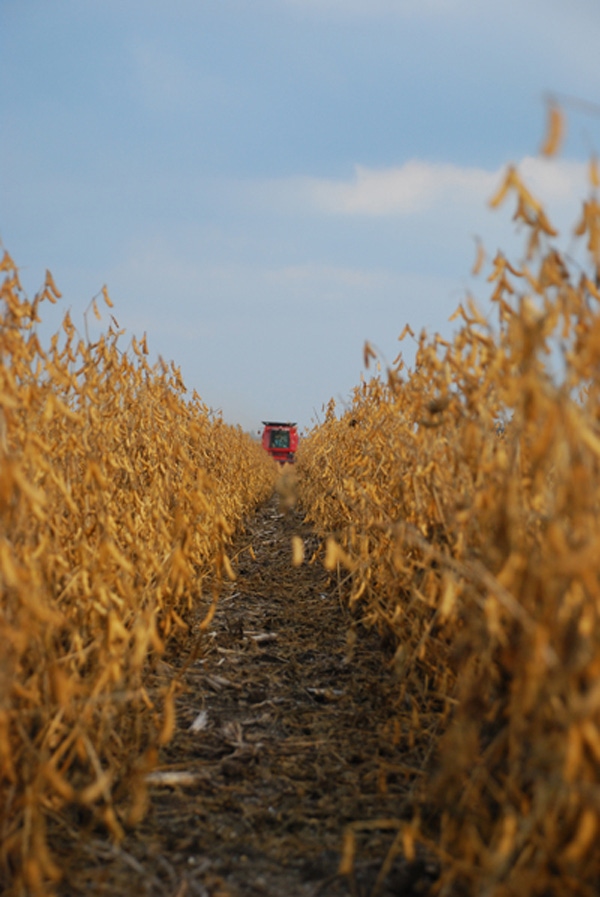February 15, 2012

Conservation has revealed itself to be quite profitable for Joe Zenz, Lancaster, WI, who topped the 2011 Non-irrigated Wisconsin Soybean Yield Contest at 92.8 bu./acre, with no-till drilled beans. "This was the first time I entered the contest, which is now in its second year," says Zenz, who planted his contest field on May 1 with Asgrow 2403 RR seed. "I knew the field had good potential, even though the fertility had been fairly low on this farm. Five years ago it was in the Conservation Reserve Program. For the first three years after the field was in CRP, I no-tilled corn into it, and I've been adding fertility to it pretty aggressively."
Last fall, Zenz applied 200 lbs. potash/acre, 100 lbs. gypsum/acre and 200 lbs. phosphorus/acre. Even more importantly, he says, is the fact that his contest acres have yet to see a plow since being enrolled in CRP for 20 years and while growing no-till corn and soybeans on it after CRP.
"I knew we were dealing with a field that had very good organic matter in it, and when I planted beans in this field last year, it was virgin soybean ground," says Zenz. "On former CRP acres, the last thing you want to do is use conventional tillage. If you no-till, then you reap the advantage of improved organic matter and water infiltration for quite a few years."
The field was also fortunate to have had timely rains, says Zenz, who farms on rolling ground in southwestern WI, about 25 miles straight north of Dubuque, IA. "Our farm was in a pocket between areas that had too much rain in the spring or too little rain during summer," he says. "We at least caught the rains when they were timely, but we also had hail damage on some fields."
Agronomic decisions
Using a drill rather than planting in wide rows also helped with canopy establishment and weed control, says Zenz. "We plant soybeans with a drill to obtain maximum use of sunlight vs. 30-in. rows," he says. "You can set the canopy much quicker with drilled beans. A good early canopy helps with weed control, plus you obtain more photosynthesis from having a canopy develop quicker."
The contest beans were planted with a John Deere 1560 drill. "In the winter, I inspect the parts on the drill and make sure the disk openers and everything else are in good shape to plant again," he says. "I also use 1590 press wheels on the drill, which are a little smaller and narrower than usual. That way, I don't leave behind as wide of a seed trench."
The variety selection was also important, says Zenz. "The Asgrow 2403s have been my best beans for several years," he says. "So, I had confidence in them for my contest field."
Zenz says he uses an inoculant on all his soybean seed every year. "I believe there's a benefit from better nodulation on the beans, and maybe it even helps the following corn crop with more nodules," he adds.
In 2011, Zenz also used the Cruiser Maxx insecticide and fungicide seed treatment combination prior to planting. On non-contest fields, he sprayed Cobra at the V3 stage to suppress white mold and other Sclerotinia diseases like stem rot.
"I scout my fields quite often, about every other day throughout the season, to watch for bugs and diseases," says Zenz. "I sprayed fungicide on my non-contest fields for Pythium root rot. We also used Leverage insecticide on aphids and Japanese beetles that the local co-op sprayed for us."
An upsurge in soybean insects and diseases has been a challenge in recent years, says Zenz. "In this area, we used to be able to count on consistently better soybean yields than we can today," he says. "I think that has a lot to do with increased insect and disease pressure. Soybean cyst nematodes and soybean aphids are the two insects that cause us the most headaches. White mold can also be a problem here in a cooler, damper year."
With hilly acreage, harvesting soybeans is another potential challenge, says Zenz. "For harvesting, we have the combine ready with the right settings and with updated equipment," he says. "We can pick up 2 bu./acre in soybean yields by using the newer 9560 John Deere combine and a 625 hydro-flex head that stays level on hillsides, which is important, because there's not too many acres of flat ground here."
Next year, Zenz says his contest field will likely go back to corn, with the addition of a cover crop. "Lately, we've been experimenting with planting a cereal rye cover crop on our corn after corn acres," he says. "We've been impressed with how that's working. The cereal rye cover crop helps break down the residue so we don't have as much residue to deal with when we're trying to plant. Last fall, we put cereal rye on corn stalks that are going into beans this year, and that also looks promising."
About the Author(s)
You May Also Like




